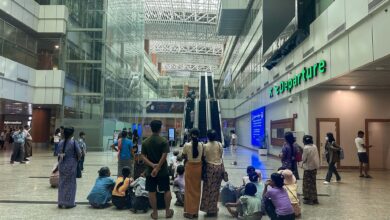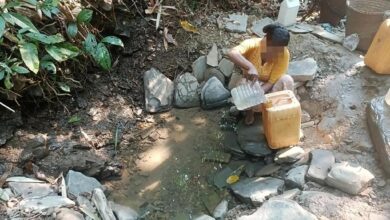
YANGON – Ei Ei Aung was working at a rice factory in Malaysia earlier this year when her grandmother back home in Myanmar became severely ill.
She decided she would return to Yangon to care for her, and then to stay home for good.
But it wasn’t that simple. She had been working in Malaysia for four years and struggled to find a job back in Yangon.
“I was working overseas during my peak years,” the 33-year-old said. “I’m not young enough to easily get hired anymore.”
Many employers in Myanmar refuse to hire applicants over the age of 35 or even 30.
Myanmar’s recent political and economic reforms mean more and more people who left the country to work abroad are considering coming home. But many who return find there is little support for them from the government or potential employers..
Migrant advocacy groups say the government needs to do far more to help people settle back in and prevent them from going back overseas.
Millions living abroad
Over the past few decades, millions have left Myanmar for work overseas. They go in search of better jobs and larger salaries to escape poverty.
With over two million of its citizens officially living abroad according to a 2014 census, Myanmar is one of the largest source countries of migrant workers in the Mekong region.
But experts estimate the actual number, including workers who go unregistered, could be double that.
Around 70 percent of Myanmar migrants are based in Thailand, with many of the rest living in Malaysia, China, Singapore and the United States.
Malaysia, where Ei Ei Aung used to work, hosts over 300,000—15 percent of all Myanmar migrants throughout the world, according to the census.
Rural poverty is a major reason many people move for work, either to other countries or to Myanmar’s cities.
Yangon has attracted over 1.4 million recent internal migrants, according to the census.
World Bank data shows that migrants sent an estimated $2.7 billion dollars to Myanmar in 2018, accounting for 3.8 percent of the country’s GDP.
For migrant workers who feel they have earned enough money to return home, settling back into their old lives can be tough.
Advocacy groups have urged the Myanmar government to set up a system to help returnees navigate local job markets with the skills they acquired abroad.
Returnees often find employers aren’t interested in the skills they acquired abroad because they weren’t certified in Myanmar, said Thet Thet Aung, director of a labour rights group called Future Light Center.
As a result, many feel they have little choice but to go abroad again. “That is the most common pattern I find in my research,” she told Myanmar Now.
Jacqueline Pollock, chief technical adviser for migration projects at the International Labour Organization’s Myanmar liaison office, said one of the biggest obstacles they face upon return is a lack of official documentation, citing an ILO survey.
“Some migrants left a long time ago without any Citizen Scrutiny Card (CSC), some have lost it over the years and do not have any record of it. Without this ID, migrants can’t access many other services or get employment,” she told Myanmar Now.
The government should also set up a system so that migrants can get certified in Myanmar for the skills they learned abroad, she added.
“Many migrants have been working in the construction industry for a long time and are highly skilled, but if they have nothing to verify these skills they would have to start at the bottom again,” she said. .
The Philippines—with more workers abroad than nearly any other Asian nations—has put policies and programs in place to reintegrate returnees, including trainings on financial literacy, money management and starting a business. It has also created a jobs database to help them find work.

Yangon native and mother of two Wai Hnin Phyu, 35, has lived in Thailand for nine years. For the past three years she has worked as a teacher at a school for migrant children in Samut Sakhon province.
Although she’s been considering a return, she doesn’t know how she would earn a living in Yangon, where her teaching experience in Thailand isn’t recognized.
“I’ve been saving some money to start my own small business when I return, but I don’t know if it’s a good idea,” she said.
“If they had business opportunities at home, they wouldn’t go outside of the country to work for other people,” said Sein Htay, secretary general of the Thailand-based Migrant Worker Rights Network.
The government must help create business models that work in sectors like agriculture, farming and tourism, and must educate returnees on how to address the obstacles their businesses will face, he said.
Sein Htay said overseas migration drains nearly 20 percent of Myanmar’s labour force, contributing to a labour shortage in infrastructure.

‘Happy return’
Pollock said agreements between Myanmar and destination countries could include clauses requiring employers to provide employment certificates to be used as credentials upon their return.
Holding job fairs in the countries where migrants currently work is another way to ease returns and offer skills assessments for Myanmar employers, she added.
The South Korean government introduced an initiative in 2009 called “Happy Return” that offered skills training and recruitment services with Korean companies for returning migrant workers.
Such initiatives are still not easily accessible to a majority of Myanmar migrant workers, said Thet Thet Aung.
Ei Ei Aung, meanwhile, has still not found any jobs that match her experience.
Struggling with uncertainty, she is now planning on starting her own flower plantation with her husband in Shan State.
“If it doesn’t work out, I’d like to go back to Malaysia and work,” she said.
Data visualization by Phandeeyar.



